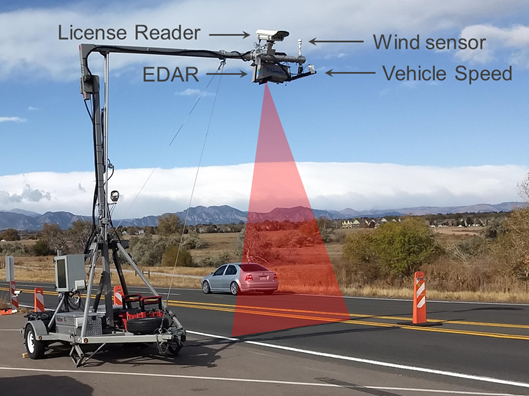ERG’s Tim DeFries, U.S. Environmental Protection Agency granted a patent for new emissions measurement technology

ERG Principal Scientist Tim DeFries is celebrating a milestone nearly 40 years in the making.
It all started in the late 1980s, when a type of remote sensing technology that could measure emissions from car exhaust was invented.
“It was amazing when it came out,” DeFries said. “Remote sensing could measure gasoline engine exhaust concentrations of vehicles as they drove on the road. Before, you could only measure emissions while a vehicle drove in the lab on a dynamometer.”
In 2008, DeFries, along with his clients at the U.S. Environmental Protection Agency (EPA), wondered if remote sensing could measure evaporative emissions from gasoline and vapor leaks, not just exhaust. They decided to solve the problem.
Compared to exhaust emissions, evaporative emissions are difficult to detect. Through a series of on-road field projects DeFries led under EPA work assignments, ERG improved evaporative emission characterization. In addition, the remote sensing instrument techniques they developed could measure not just concentrations, but the actual mass of the emissions. This was a major development that will help to better quantify vehicle emissions and pollution at a larger scale.
On March 11, 2025, DeFries, the EPA, and Scott Douglas, ERG’s subcontractor and signal analysis professor at Southern Methodist University, were granted a patent for a first-of-its-kind remote sensing technology that can measure the mass of any type of emissions. Patent No. 12248945, System and Method for Quantifying Source and Component Emissions Rates from a Body in a Flow Field, is Tim’s first patent.
Here’s how it works:
A laser takes an infrared picture of all the air around a moving vehicle—including the plume coming out of a vehicle’s tailpipe. The image, coupled with measurements of the vehicle’s aerodynamics, allows the instrument to measure not just concentrations, but masses of evaporative and exhaust emissions like carbon monoxide, hydrocarbons, nitrogen oxides, carbon dioxide, and other harmful air pollutants.
Measuring mass is a critical improvement that will further EPA’s goal of quantifying the pollutants vehicles emit into the atmosphere at a national level. The patent will further help state and national organizations in the identification of vehicles with faulty emissions reduction systems, potentially streamlining future inspection and maintenance programs.
The technology is especially useful for measuring emissions from medium- and heavy-duty trucks, like 18-wheelers, which are responsible for much of today’s on-road emissions but are difficult to fit inside most labs.
DeFries says the goal of patenting the technology was to make sure it stays free and available to everyone.
“We want other people to use this idea,” he said.
Click here for more information on ERG’s Clean Transportation service area.